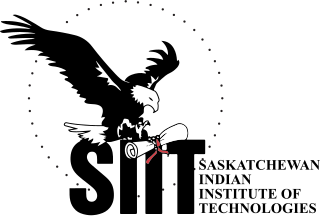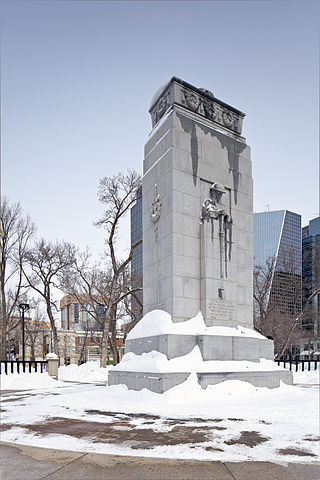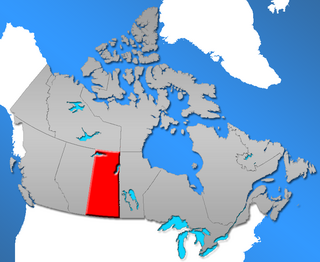Related Research Articles

Saskatchewan is a province in Western Canada, bordered on the west by Alberta, on the north by the Northwest Territories, on the east by Manitoba, to the northeast by Nunavut, and to the south by the United States. Saskatchewan and Alberta are the only landlocked provinces of Canada. In 2024, Saskatchewan's population was estimated at 1,231,043. Nearly 10% of Saskatchewan's total area of 651,900 km2 (251,700 sq mi) is fresh water, mostly rivers, reservoirs, and lakes.

The Saskatchewan Indian Institute of Technologies (SIIT) is a First Nations-operated post-secondary institution offering training and educational programs in Saskatchewan, Canada.
The Provincial Archives of Saskatchewan is an arms-length government agency with offices in Regina, Saskatchewan, Canada. The archives holds public and private records which include audio tapes, video, photographs, maps, publications and other material.
The Métis Nation—Saskatchewan is a federally-recognized government that represents Métis people in the province of Saskatchewan, Canada. It is affiliated with the Métis National Council. Glen McCallum was elected as president in 2017 and reelected in 2021.

Saskatoon Arena was an indoor arena located in Saskatoon, Saskatchewan, which opened in October 1937, and which was demolished in March 1989. The arena was situated in downtown Saskatoon, on a site overlooking the South Saskatchewan River. It was the city's main entertainment venue for a half-century, before it was replaced in 1988 by Saskatchewan Place.

Victoria Park is a public park in the centre of downtown Regina, the capital of the Canadian province of Saskatchewan.

The geography of Saskatchewan is unique among the provinces and territories of Canada in some respects. It is one of only two landlocked regions and it is the only region whose borders are not based on natural features like lakes, rivers, or drainage divides. The borders of Saskatchewan, which make it very nearly a trapezoid, were determined in 1905 when it became a Canadian province. Saskatchewan has a total area of 651,036 square kilometres (251,366 sq mi) of which 591,670 km2 (228,450 sq mi) is land and 59,366 km2 (22,921 sq mi) is water.
The Politics of Saskatchewan relate to the Canadian federal political system, along with the other Canadian provinces. Saskatchewan has a lieutenant-governor, who is the representative of the Crown in right of Saskatchewan; a premier—currently Scott Moe—leading the cabinet; and a legislative assembly. As of the most recent provincial election in 2020, the province is divided into 61 electoral districts, each of which elects a representative to the legislature, who becomes their member, or MLA. In 2020, Moe's Saskatchewan Party was elected to a majority government. Regina is the provincial capital.

The Peter MacKinnon Building is a National Historic Site of Canada which is part of the University of Saskatchewan. The U of S is the largest education institution in the Canadian province of Saskatchewan. The structure is an example of a university building in the classic Elizabethan E shape in Collegiate Gothic style which was designed by Brown and Vallance.
Ian E. Wilson is a former chief Librarian and Archivist of Canada. Appointed in 2004, he had previously been National Archivist of Canada. With Roch Carrier, the then National Librarian, he developed and led the process to link the National Archive and National Library as a unified institution. His distinguished career has included archival and information management, university teaching and government service. In addition, he has published extensively on history, archives, heritage, and information management and has lectured both nationally and abroad. Wilson retired as head of LAC in April 2009.

Krydor is a village in the Canadian province of Saskatchewan within the Rural Municipality of Redberry No. 435 and Census Division No. 16. The community's name is a combination of the names of two early settlers, Petro Krysak and Teodor Lucyk. Petro Krysak also served as the first postmaster, from September 1, 1911, to July 7, 1913.

George Hara Williams was a Canadian farmer activist and politician.

Historically, Saskatchewan's higher education system has been "significantly shaped" by demographics. In 1901, six years prior to the 1907 founding of a university in Saskatchewan, the urban population in Saskatchewan was 14,266 (16%) while the rural population was 77,013 (84%). One hundred years later, the proportions had changed significantly: urban population in 2001 was 629,036 (64%) while the rural population was 349,897 (36%). Over time the province's higher education system has changed significantly in response both to this demographic shift and to provincial politics.
The Association for Manitoba Archives (AMA) is a voluntary organization dedicated to the preservation of the documentary heritage of the people and institutions of the province of Manitoba, Canada, by improving the administration, effectiveness and efficiency of the province's archival systems. The membership is made up primarily of archivists and archival institutions, but anyone who is interested in supporting the mandate of the organization can join.
Shelley Sweeney is a Canadian archivist. She was university archivist at the University of Regina from 1983 to 1998, and the Head of the University of Manitoba Archives & Special Collections from 1998 to 2020. She helped found two regional archival organizations, the Saskatchewan Council of Archives and the Saskatchewan Archivists Society, and the University and Research Institutions section of the International Council on Archives. Sweeney is a charter member of the Academy of Certified Archivists and, with colleagues, wrote the first code of ethics for the Canadian archival profession.
Alban Cedric Ellison was an English-born lawyer and political figure in Saskatchewan, Canada. He was mayor of Regina from 1936 to 1939.
Lauder is a small community in the Rural Municipality of Grassland in the Canadian province of Manitoba. The community is located at the junction of Highway 254 and Highway 345, approximately 100 km south-west of Brandon only 22 km south-west of the Town of Hartney. Lauder is about 3 miles south of the Souris River and the Lauder Sand Hills.
The Association of Canadian Archivists (ACA), established in 1975, is a national not-for-profit organization representing over 600 archivists in Canada. With headquarters in Ottawa, the ACA's mandate is to provide leadership to the archival profession and to increase an understanding and appreciation of Canada's archival heritage.